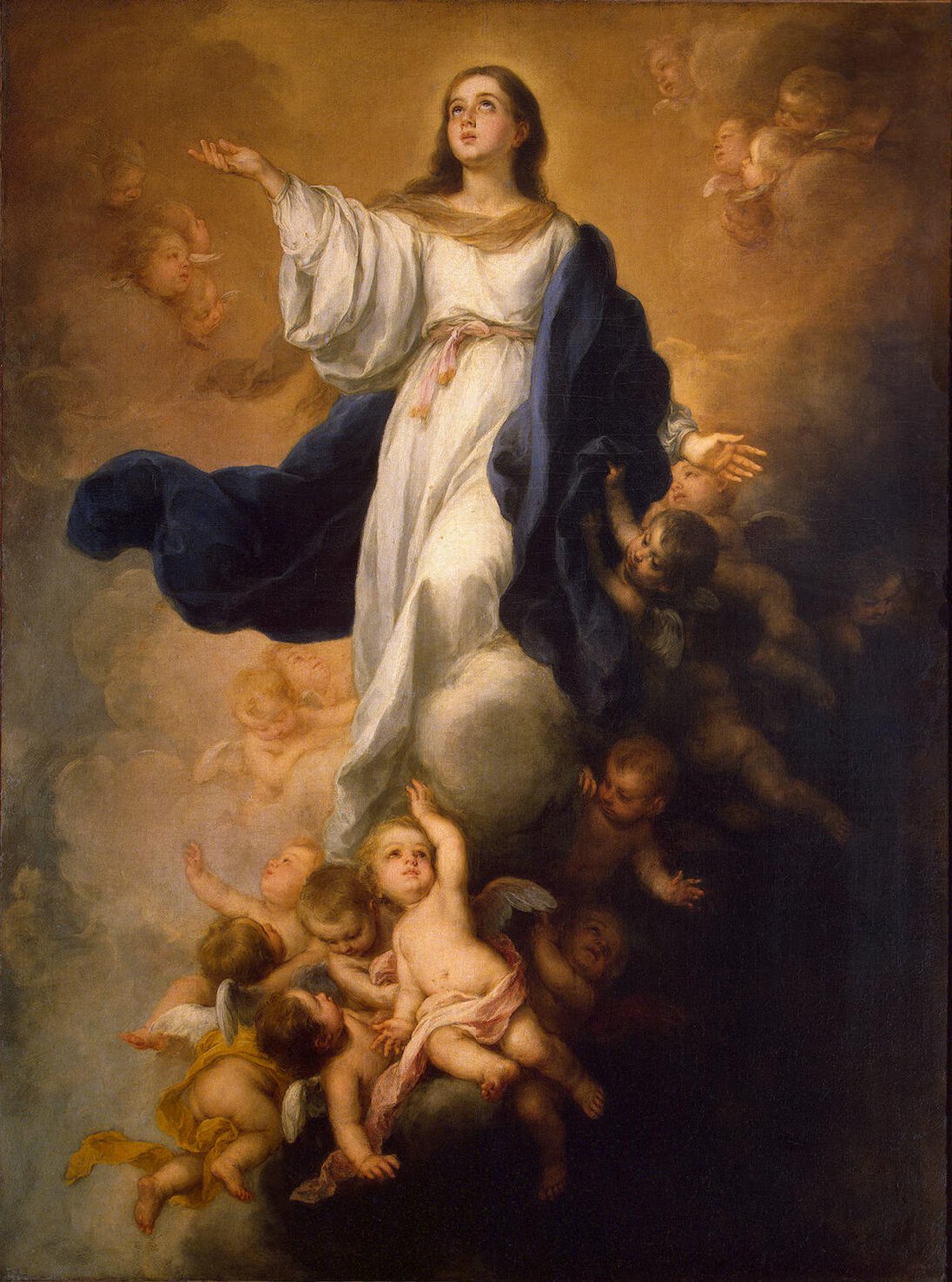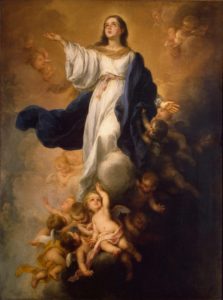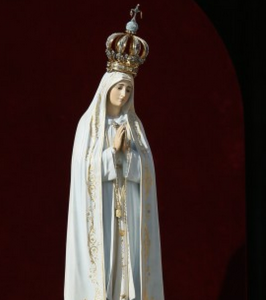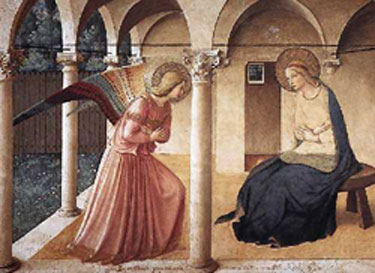While the actual event of the Assumption of Mary into Heaven is not recorded in the Scriptures, there is a biblical basis for the teaching that, considered as a whole, confirms Catholic teaching as both fitting and in keeping with biblical principles. Let’s ponder this feast in stages:
The Assumption Explained – To be “assumed” means to be taken up by God bodily into Heaven. As far back as the Church can remember we have celebrated the fact that Mary was taken up into Heaven. We do not just acknowledge that her soul was taken to Heaven, as is the case with the rest of the faithful who are taken there (likely after purgation); rather, Mary was taken up, soul and body, after her sojourn on this earth was complete. There is no earthly tomb containing her body, neither are there relics of her body to be found among the Christian faithful. This is our ancient memory and what we celebrate today, Mary was taken up, body and soul, into Heaven.
The Assumption Exemplified – While Mary’s Assumption is not described in Scripture, several other “assumptions” are; thus the concept itself has a biblical basis. The actual event of the Assumption is not described in Scripture. However, there are “assumptions” recorded in the Scriptures and thus the concept is biblical.
Enoch – Enoch walked with God; then he was no more, because God took him away (Gen. 5:24). By faith Enoch was taken up so that he should not see death; and he was not found, because God had taken him. Now before he was taken he was attested as having pleased God (Hebrews 11:5).
Elijah – And as they still went on and talked, behold, a chariot of fire and horses of fire separated the two of them. And Elijah went up by a whirlwind into heaven … And he was seen no more (2 Kings 2:11).
Moses – Some say that because the location of Moses’ grave is not known, he too was taken up into Heaven. We read in Monday’s first reading at daily Mass: He was buried in Moab, in the valley opposite Beth Peor, but to this day no one knows where his grave is (Dt. 34:6). The text of course does not say that his body was taken up, and if it was, it occurred after death and burial. The Book of Jude hints at this: But even the archangel Michael, when he was disputing with the devil about the body of Moses … (Jude 1:9). Some further credibility is lent to the view of Moses being assumed by the fact that he appears with Elijah in the account of the Transfiguration. Some of the Church Fathers also held this opinion. Further, there is a Jewish work from the 6th century A.D. entitled The Assumption of Moses. In the end, though, the assumption of Moses is not officially held by the Church.
The Assumption Evidenced (John Sees Mary in Heaven) – There is one other scriptural account that may provide evidence of Mary’s whereabouts. Today’s second reading, a passage from the Book of Revelation, features John’s description of his sighting of the ark of God:
Then God’s temple in heaven was opened, and within his temple was seen the ark of his covenant. And there came flashes of lightning, rumblings, peals of thunder, an earthquake and a great hailstorm. A great and wondrous sign appeared in heaven: a woman clothed with the sun, with the moon under her feet and a crown of twelve stars on her head. She was pregnant and cried out in pain as she was about to give birth. Then another sign appeared in heaven: an enormous red dragon with seven heads and ten horns and seven crowns on his heads …. The dragon stood in front of the woman who was about to give birth, so that he might devour her child the moment it was born. She gave birth to a son, a male child, who will rule all the nations with an iron scepter (Rev 11:19 – 12:5).
The woman in the passage is clearly Mary, since the child is obviously Jesus (although she also likely represents Israel and Mother Zion). And where is Mary seen? In Heaven. Some argue that this does not necessarily indicate that her body is in Heaven; they say that it might be referring only to her soul. However, the physical description of her seems rather strong to support such a view.
Others believe that because John mentions the ark and then continues on to describe Mary (the woman clothed with the son), that he is in fact still describing the ark. (I have written on this elsewhere: Mary: The Ark of the New Covenant.) If Mary is the ark described, then she is clearly in Heaven.
So, the Bible, while not specifically recording Mary’s Assumption, does present other assumptions, thus showing it to be a biblical concept. Further, Mary’s physical presence in Heaven seems at least hinted at, if not directly described, in the Book of Revelation.
The Church does not rely solely on Scripture. In this case, what we celebrate is most fundamentally taught to us by Sacred Tradition; the memory of Mary’s Assumption goes back as far as we can remember.
The Assumption Extended to Us – The Feast of the Assumption is of theological interest and provides matter for biblical reflection, but eventually these questions are bound to arise: So what? How does what happened to Mary affect my life? What does it mean for me? The answers are bound up in nearly every Marian doctrine. Simply put, what happened to Mary will also happen to us in the end. As Mary bore Christ into the world, we bear Him in the Holy Communion we receive and in the witness of His indwelling presence in our life. As Mary is (and always was) sinless (immaculate), so too will we one day be sinless with God in Heaven. As Mary cared for Christ in His need, so do we care for Him in the poor, suffering, needy, and afflicted. Finally, as Mary was assumed, body and soul, into Heaven, so too will we be there one day, body and soul.
After our death and subsequent purification, our soul goes to Heaven; our body, though, lies in an earthly tomb. But one day, when the trumpet shall sound, our body will rise and be joined to our soul.
For we will all be changed—in a flash, in the twinkling of an eye, at the last trumpet. For the trumpet will sound, the dead will be raised imperishable, and we will be changed. For the perishable must clothe itself with the imperishable, and the mortal with immortality. When the perishable has been clothed with the imperishable, and the mortal with immortality, then the saying that is written will come true: “Death has been swallowed up in victory. Where, O death, is your victory? Where, O death, is your sting?” … Thanks be to God. He gives us the victory through our Lord Jesus Christ (1 Cor 15:51-57).
So our bodies shall rise; they shall be assumed and joined to our soul.
Improved model! An older woman once said to me, upon hearing that her body would rise, “Father if this old body has to rise, I’m hoping for an improved model!” Yes, indeed; me too! I want a full head of hair, a slim build, and knees that work! I want an upgrade from this old, general issue model to a luxury edition. In fact, God will do that. Scripture says,
- He will take these lowly bodies of ours and transform them to be like his own glorified body (Phil 3:21).
- But someone may ask, “How are the dead raised? With what kind of body will they come?” How foolish! What you sow does not come to life unless it dies. When you sow, you do not plant the body that will be, but just a seed, perhaps of wheat or of something else. But God gives it a body as he has determined, and to each kind of seed he gives its own body …. So will it be with the resurrection of the dead. The body that is sown is perishable, it is raised imperishable; it is sown in dishonor, it is raised in glory; it is sown in weakness, it is raised in power …. And just as we have borne the likeness of the earthly man, so shall we bear the likeness of the man from heaven (1 Cor 15:35-49).
- I know that my Redeemer lives, and that in the end he will stand upon the earth. And after my skin has been destroyed, yet in my flesh I will see God; I myself will see him with my own eyes—I, and not another’s (Job 19:25-27).
The assumption of our bodies, prefigured by Christ in His own power and also in Mary by the gift of God, will one day be our gift too.
The following song is an African-American spiritual and describes that “great gettin’ up morning” when our bodies will rise. If we have been faithful, our bodies will rise to glory!
I’m gonna tell you about the coming of the judgement (Fare you well) There’s a better day a coming …. In that great gettin’ up morning fare you well! Oh preacher fold your Bible, For the last soul’s converted …. Blow your trumpet Gabriel …. Lord, how loud shall I blow it? Blow it right calm and easy Do not alarm all my people …. Tell them to come to the judgement …. In that great gettin’ up morning fare you well. Do you see them coffins bursting? Do you see them folks is rising? Do you see the world on fire? Do you see the stars a falling? Do you see that smoke and lightning? Do you hear the rumbling thunder? Oh Fare you well poor sinner. In that great gettin’ up morning fare you well.










